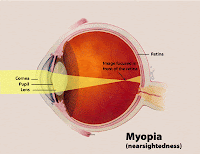The ciliary muscles control the curvature of the eye lens and hence alters the focal length of the eye lens. For clear vision the image of the object must be formed on the retina. Sometimes the image of the object might not be formed on the eye's retina, causing difficulty in seeing the object clearly. This can happen due to factors such as change in the curvature of the eye and damage to the eye lens.
There are mainly 4 defects of vision :
- Near-sightedness (Myopia)
- Far-sightedness (Hypermetropia)
- Presbyopia
- Astigmatism
Nearsightedness
- It is also called myopia.
- A person suffering from this defect cannot see distant objects clearly.
- This is because the light rays from distant objects converge before the retina even when the focal length of the eye is maximum.
- Further strain does not help.
 Causes:
Causes:
- Eye lens is too thick
- Radius of eye is larger than usual. i.e more than 2cm.
- Decrease in the maximum focal length which is caused when the cillary muscles holding the eye lens cannot relax completely and have some tension.
Treatment:
- The treatment is simple and painless.
- Since the light rays are converging too much, they are made to diverge a bit before they enter the eye. This is done by using a diverging lens or a concave lens.
- IMPORTANT: The convex lens makes it appear that the light rays from distant objects are coming from the apparent far point of the eye.
Farsightedness
- A person suffering from this defect can see distinct objects clearly but is unable to see clearly the object close to his eyes.
- In this the rays coming from close objects focus behind the retina. Therefore the diverging power of the lens is reduced.
- In this the least distance for clear vision increases and hence the person is unable to see objects placed between the apparent near point and the normal fear point (25cm).
- This usually occurs to elder people. This defect makes it hard to read textbooks ad newspapers.
 Causes:
Causes:
- It is also known as hypermetropia.
- It occurs when the eye lens is thinner at the center.
- Decrease in the radius of eyeball.
- Increase in the minimum focal length of the eye lens and hence the person is unable to decrease the focal length to view close by objects. The cillary muscles even in their most strained state are unable to decrease the focal length.
- Weakening of the cillary muscles. This condition in which hypermetropia is caused due to weakening of the cillary muscles is known as presbyopia.
Treatment:
- The treatment is simple and painless. Since the rays are diverging too much, they are made to converge a little before they enter the eye. This can be done by using a converging lens or a convex lens.
- The convex lens makes it appear that the light rays from the close objects are coming from the apparent near point of the eye.
Presbyopia
- A person suffering from this eye defect is unable to see close objects clearly. This is similar to hypermetropia and is cause due to weakening of the cillary muscles as mentioned above.
- The near point of the eye increases.
Causes:
- This is mainly seen in older people and is caused to weakening of the cillary muscles.
- The flexibility of the lens decreases.
Treatment:
- The treatment is simple and painless. Since we cannot see close objects clearly, a convex lens is used.
Astigmatism
- A person suffering from this defect is unable to see all the directions clearly. In this the person is unable to focus on horizontal and vertical planes at the same time.
Causes:
- It is caused when the eye develops different curvatures along different planes. Hence there is a change in the shape of the eyeball.
Treatment:
- The treatment is simple and painless. Lenses with different curvatures along different planes are used. This compensates for the deshaping of the eyeball. These lenses are called cylindrical lenses.







thx! this really helped me to prepare for my exam!
ReplyDelete